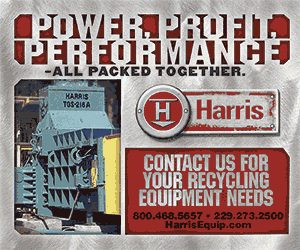
Bridget Anderson
New York City’s waste management systems have seen a lot of change since the 1800s, when all materials were loaded onto a barge, taken into the ocean and dumped overboard. That system is currently transforming once again.
The current materials management goal for America’s largest metropolis is to eventually send none of its material for disposal.
“This is not an easy question, there are cities all over the country that are trying to tackle a zero waste plan to figure out how we’re going to do this,” said Bridget Anderson, deputy commissioner of recycling and sustainability for the New York City Department of Sanitation (DSNY). “What we’re learning is, it’s all hands on deck. It’s not just one agency that’s going to solve this problem, it’s really a step-by-step approach.”
Anderson laid out her thoughts during a recent webinar hosted by the National Recycling Coalition and the Pennsylvania Recycling Markets Center.
Pieces of the pie
As the city of more than 8.5 million residents began working toward the zero waste target, officials first conducted a waste characterization study in 2013 to get a handle on what the local waste stream looked like.
It was determined about a third of the city’s waste stream was made up of materials that were already accepted for recycling. This established infrastructure included paper, cardboard, rigid metals, glass, cartons, plastics and other materials common to municipal curbside programs.
But about half of the city’s recyclables are not collected for recycling, Anderson said, meaning the first step is to determine how to begin capturing that portion. Some of the barrier is the physical setup of properties in the city. For instance, 500,000 New York residents live in public housing developments, Anderson said, most of which were built before recycling was a common offering.
“There is very little space to set up recycling infrastructure and build in these public housing buildings,” Anderson said. That means virtually all the recyclables in those units are going to disposal.
New York runs a dual-stream system with paper and cardboard in one bin and metal, glass and plastic in a second. It’s the “only big city in the country that has not gone single-stream yet,” Anderson said, and the city is looking into changing that. Officials favor single-stream because it would ease space constraints, as only one truck would be needed where two are used now.
A single-stream system could also increase volume collection, and although Anderson said city officials know it can also raise contamination rates, they don’t feel it will be a significant problem for downstream vendors since the program is already “fairly inclusive” as is.
Eyeing organics segment
Anderson also noted that compostable organics make up another third of the waste stream, and the city has plans to expand in that area as well. DSNY has committed to expand organic material collection to all 8.5 million residents by the end of 2018, and is “pretty far along,” Anderson said. Single-stream recycling would also benefit organics collection by consolidating to a three-bin system for recycling, organics and garbage.
Organics collection is being implemented in phases, both to get residents accustomed to separating food scraps, and also to help DSNY learn residents’ habits. For instance, as the program has expanded, officials have learned residents like to bag their material, which the program has worked to accommodate.
“To get broad participation in a program, we have to find a way to accept the behavior that people are going to have, to get them to participate,” she said. That has remained a challenge, as residents often use plastic grocery bags rather than compostable or paper bags.
The final third of the waste stream is made up of “other” materials. Some have no current widespread recycling market. In this realm, the city has taken the approach of looking for recyclable alternatives. A controversial ban on expanded polystyrene food-service packaging is an example of this tactic.
Hazardous waste, textiles and e-scrap also fall into the “other” category, and have received their own recycling initiatives. The e-cycleNYC program offers free e-scrap drop-off in multi-family buildings, and the Re-FashioNYC program does the same with textiles.
To increase diversion of non-recyclable items, the city also promotes a “robust reuse community,” Anderson said, with an online exchange platform.
Big picture
Outside the specific initiatives underway, Anderson said the city is looking at recycling and waste reduction opportunities on a wider scale. Leaders are considering incentivizing recycling through a pay-as-you-throw system, since collection is currently funded through taxes and is often seen as “free” by residents, Anderson said. In pay-as-you-throw arrangements, residents are charged more as their trash volumes increase. For the next year, a consultant will study the feasibility of that option.
Franchise zones are also being studied, she said, as a way to cut down on redundancy within the commercial collection sector. As is, the system is a free market with private haulers.
As to whether the city’s diversion goals could be met with more controversial measures like mixed waste processing technology, Anderson said at this point the output is not of high enough quality to warrant its use.
“We have experimented with that, but we found that the outcomes, the beneficial commodities coming out were not that good,” she explained. “But it doesn’t mean that technologies and innovations can’t be improved. We’re agnostic as to what opportunities might be out there as long as they are effective at creating the beneficial commodities that we need to ensure that we’re beneficially using the material. Right now we’ve committed to a source separation system.”
More stories about local programs
- Interstate Waste buys North Atlantic in Connecticut
- Iowa firm recycles wind turbine blades into concrete
- California’s 2024 carpet recycling rate exceeds annual goal



